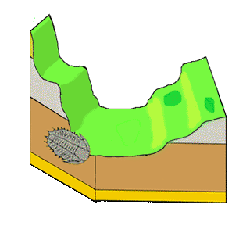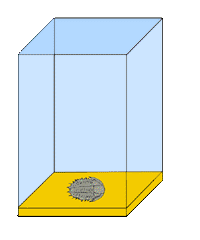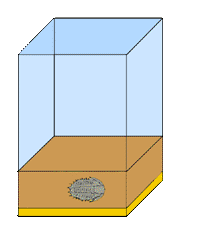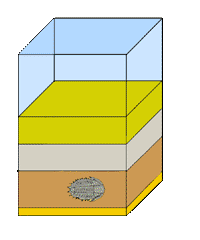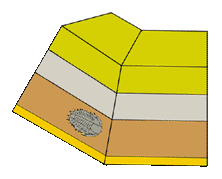Sign up for Lesson Plans, discounts & more!
Fossil Formation
Your Illustrated Guide to Fossilization
Fossil formation Is easy to understand with this illustrated guide. It is presented here with pictures and a descriptive tour of the process of Permineralization which is the most common process for preserving ancient plant and animal material.
Common is a relative term when used in regards to fossils. Though there are millions of fossils that have been discovered and millions more waiting to be discovered, fossilization is a rare occurrence.
Fossil Formation Is A Rare Occurrence
There have been untold billions of creatures that have lived on the planet during the last 550 million years. When conditions on Earth caused mass extinctions, literally thousands, perhaps hundreds-of-thousands of species went extinct. For these species to be preserved, a series of truly fortunate events had to have occurred. If even one of these events failed, that animal or species would never be seen by modern eyes.
Nature Recycles
Because
of this, fossilization is actually a rare occurrence. It goes against
the laws of nature that favor recycling. Just about everything that
exists naturally on the planet, animals, plants, rocks and minerals,
are designed to be reused or reformed to support some other species or
life-form.
Food For Thought
Let’s narrow it down to
animal species for a moment. All animals are designed to be someone
else’s lunch. All parts, even the leftover bones, can be consumed by one
species or another…right down to the bacteria that decomposes the
sturdiest bones and shells. This makes a very bad situation for the
formation of fossils. Since every part is designed to be gobbled up, the process has to happen before someone or something gets a
hold of the food!
Fossil Formation: An Illustrated Representation
The Process
In the first step of fossil formation an animal or plant must die in water or near enough to fall in shortly after death. The water insulates the remains from many of the elements that contribute to decomposition. In the following example a trilobite has died of old age on the bottom of the sea. Bacteria consume the soft body parts but leave the hard exoskeleton intact.
Sedimentation
As
time passes sediments bury the exoskeleton. The faster this happens the
more likely fossilization will occur. Land and mud slides definitely
help. River deltas are also good for quick accumulation of sediments.
This further insulates our trilobite from decomposition.
The sediments themselves have a huge influence on how well our trilobite fossil turns out. Very fine grained particles, like clays, allow more detail in the future fossil. Course sediments, like sand, allow less detail to show. The chemical make up of the sediments also contributes to the future fossil. If iron is present it may give the rock a reddish color. Phosphates may darken the rock to gray or black. The possibilities are truly endless.
Permineralization
As
the sediments continue to pile on, the lower layers become compacted by
the weight of the layers on top. Over time, this pressure turns the
sediments into rock.
If mineral-rich water percolates down through the sediments, the fossil formation process has an even better chance of preserving our ancient animal. Some of the minerals stick to the particles of sediment, effectively gluing them together into a solid mass. These minerals make an impact on our original trilobite as well. Over the course of millions of years they dissolve away the outer shell, sometimes replacing the molecules of exoskeleton with molecules of calcite or other minerals. In time the entire shell is replaced leaving rock in the exact shape of the trilobite. That is the fossilization process at work.
Uplift
As the continental plates move around the earth,
crashing into each other, mountains are formed. Former sea floors are
lifted up and become dry land. This is exactly what has happened to our
trilobite in the picture below. Now fossil is complete but our
trilobite is buried under hundreds or even thousands of feet of rock!
Thanks to the movement of the plates, our trilobite will come closer to
the surface and nearer to discovery by some fortunate fossil hunter.
Luckily nothing stays the same.
Erosion at work
Fossil formation is revealed by erosion. Wind,
rain, freeze and thaw, even earthquakes will help force the trilobite
out of its burial ground and out into the light. If he or she is lucky
enough, the trilobite will reveal itself in time to be spotted by a
rock-hounder or fossil-digger. Who knows? It could even be YOU!
Interested in purchasing your own fossils? head over to Fossilicious for great priced Specimens.
Check out some of the Educational Materials for sale on our sister site fossilicious.com.

interested in more? If so, you may want to check out our other sites:
fossilicious.com - Our online fossil and mineral rock shop.
rocksandminerals4u.com - An educational site about rocks, minerals, and geology.
Geologic Time Geologic Time Line
Cenozoic Era
Quaternary
Neogene
Paleogene
Mesozoic Era
Cretaceous
Jurassic
Triassic
Paleozoic Era
Permian
Carboniferous
Devonian
Silurian
Ordovician
Cambrian
Archean Time
Hadean Time
Teachers Resources
Activities for Education and Fun
Earth Science Lesson Plans
Activities For Kids
Fossil Lesson Plans
Fossil Activities
Education Articles
Coloring Pages
Dinosaur Coloring Pages
Montessori Materials
Geology Club
Fossil Hunting
 |
 |
 |
